It only takes a quick look to realise there is something different about Oros: its art style lies between the abstract or painterly detailed art of most games, the box is a bit bigger than usual (approximately 1.5x Ticket-to-Ride-boxes), the mood is unusually cheerful for a game about demigods, reminding me of an animated movie or children’s TV series. There is simply something endearing about this game’s theme and production. So when I heard someone describe it as “Populous the board game”, it was what folks call an insta-buy. I could not count the numbers of hours (or should I say days? weeks?) I have spent playing the original Populous PC game back in the days, raising and lowering the lands, helping my people to flourish and on occasion drowning the opponent’s population in the sea or planting a volcano in their mids. Aaaahh, good times…
Let’s dig into first time author Brandt Brinkerhoff’s Oros and see what lies beneath the pretty art, whether it is more Populous or Labyrinth. Let’s become demigods…
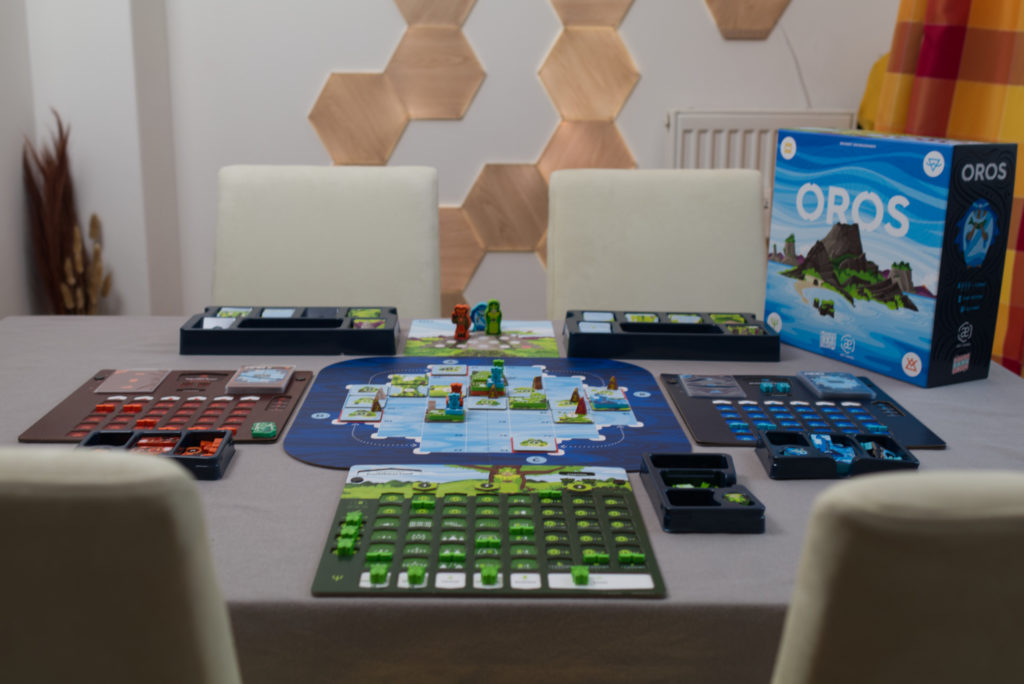
Setup
When lifting the box’s cover, my first thought was: yep, it’s a Kickstarter game, as the trays and inlay greeted me. They noticeably speed up setup though, making the whole affair are rather quick thing. Put the two trays of land tiles somewhere in reach, fold out the main board and place the pyramid track next to it, give each player a player board and the tray with the wooden pieces of their colour, and you’re mostly done.
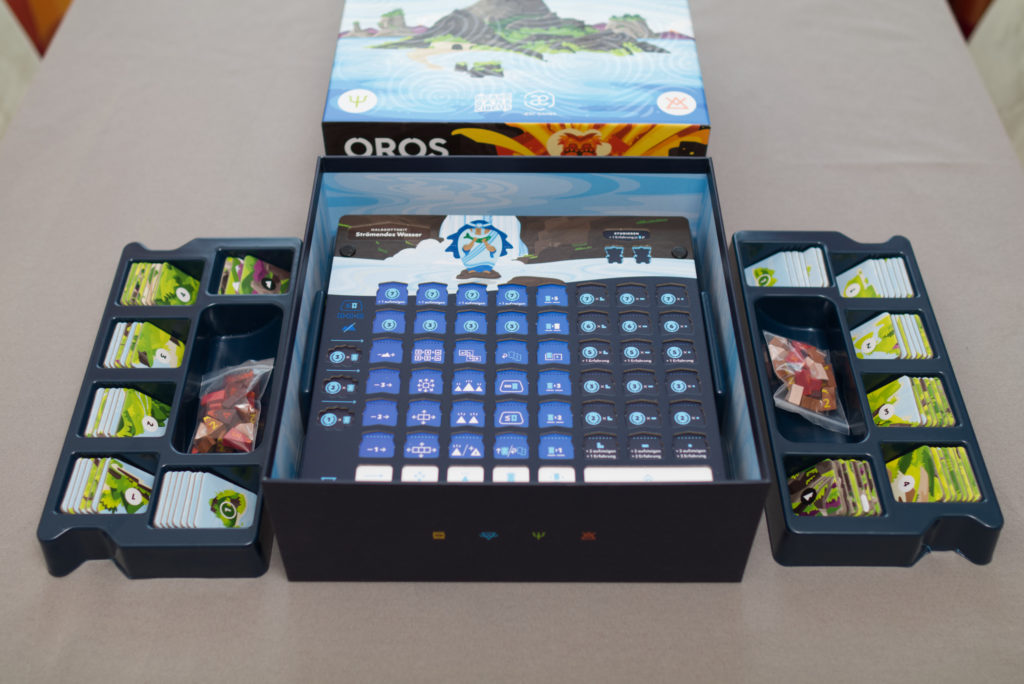
So let’s take a second to talk about the components. The main board shows the globe on which the game will happen, with a smaller 1-3 player side on the front and a 4 player side on the back. On the board, various islands, pieces of land and volcanos are placed to form the initial continents. There are multiple recommended setups in the rules which do not change the game fundamentally but create incentives to focus on various aspects of the game like volcanos or movement. The board itself has rounded corners, which is a nice touch to remind players this is not a flat earth but a globe. During the course of the game, players will move the lands all over the playing area and in good old Pacman fashion, what goes out on one side must come back in on the other.
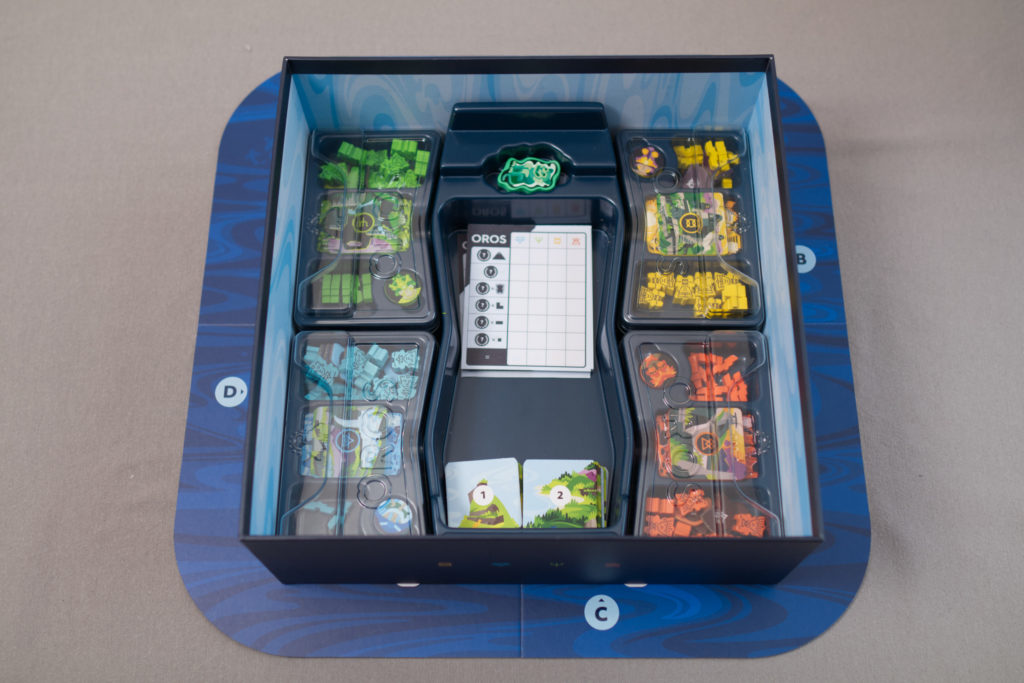
The smaller Pyramid board is actually not a board but rather a thin sheet of plastic or coated paper, I’m not sure. It also has two sides, the regular 1-3 player side and the 4 player side with a longer track on it. Players advance on this track, which is worth VP at the end, but it mostly acts as a timer. Whenever the first player moves on a red space, new volcanos are added and as soon as someone reaches the top of the Pyramid, the current round is completed and the game ends. Unlike Populous, Oros is not an area control game, there is no “population”, but it is rather a race for “knowledge” (=VP) before the game is over all too quickly.
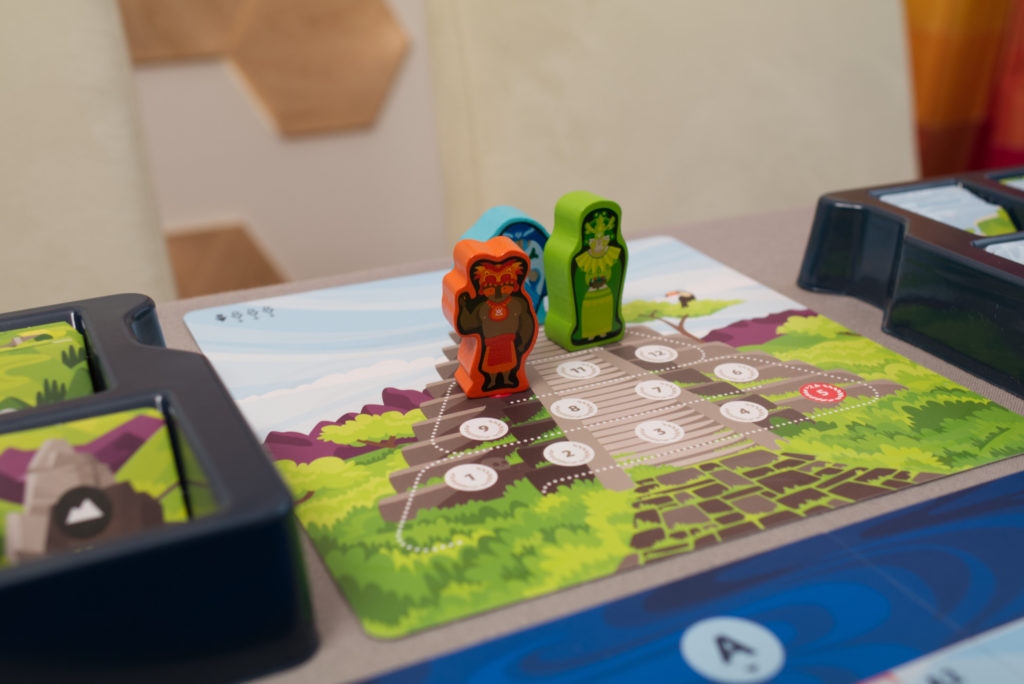
Looking at the land tiles, they are thick cardboard pieces (first time I’ve ever seen tiles with spot UV!) with values from 1-4 matching the number of land-sides on the tile. There are also islands, which have a 1 on them but have no land side at all, as well as mountains which are all land and will become very important later on. Note that unlike games such as Carcassonne, adjacent tiles in Oros do not have to have matching sides. So a land side can butt directly against the sea side of another tile, but only if two land sides are next to each other are they considered connected.
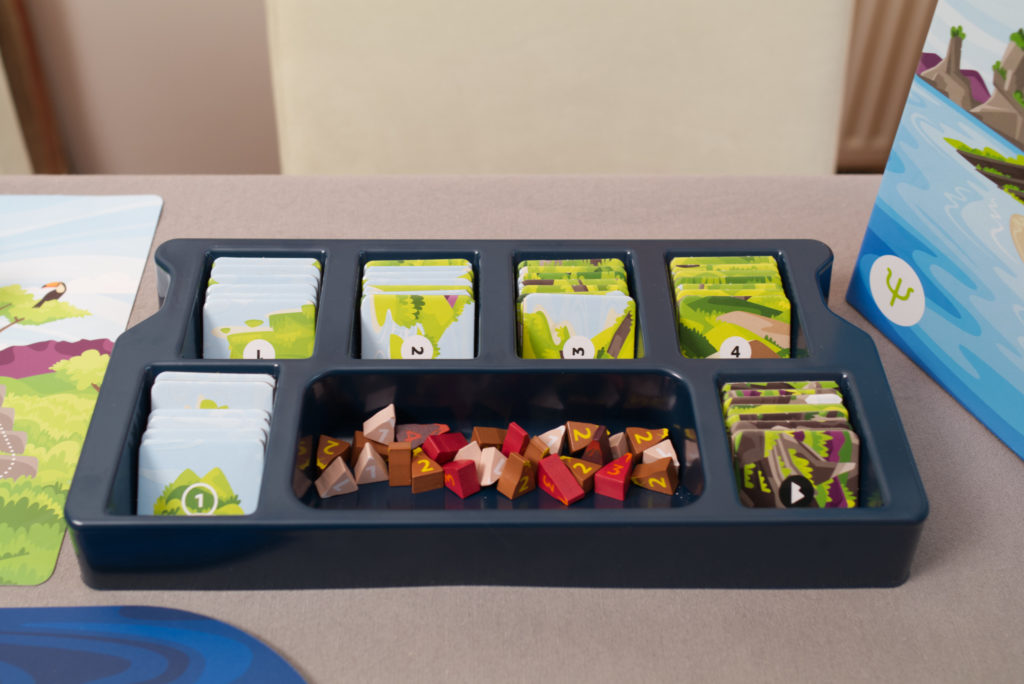
Finally, there are the player components. Each player has a three-layer board (which is held together by two plastic pins) showing the various actions a player can take during their turn. As part of setup, each player slots small thin wooden pieces into each column. These represent the strength or knowledge you have in that particular action. For example, initially the players’ shift action only allows them to move the lands by one square. But gaining experience allows them to move the little barrier upwards, increasing the strength of that action whenever they take it.
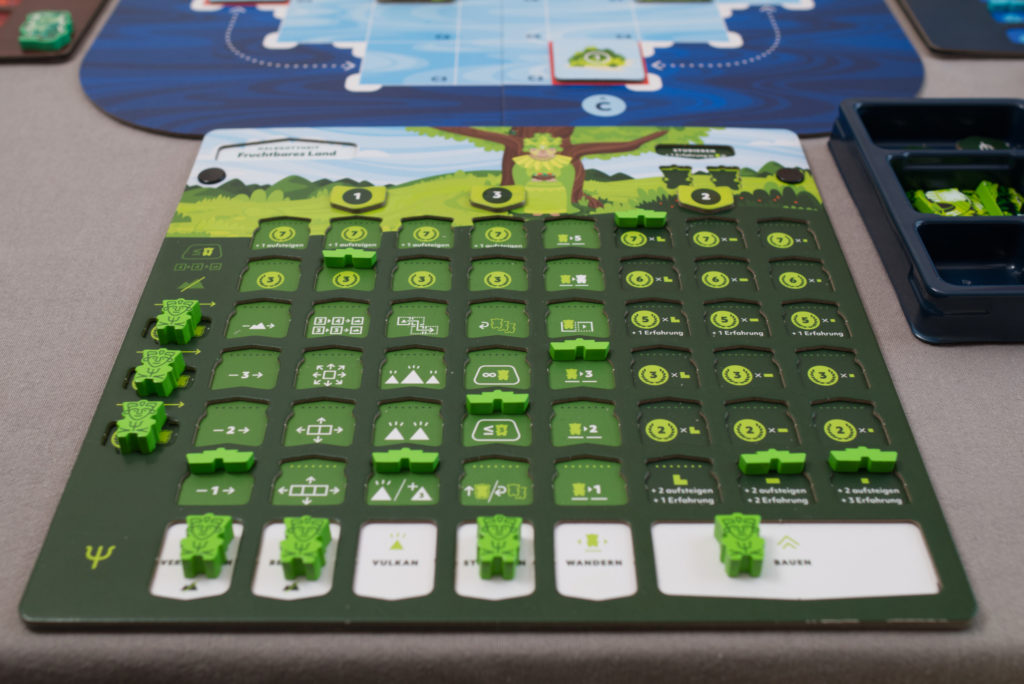
Speaking of action, at the bottom of each column is a single white space. These are the worker placement spots.
The Turn
During their turn, a player can perform three actions by taking an existing meeple off one of their white action spaces and moving it to another one that is unoccupied. So if one is standing on the Study space and none on the Shift space, the player can take that meeple to perform the Shift action, moving lands around. They cannot however use the Study action as long as a meeple is on there.
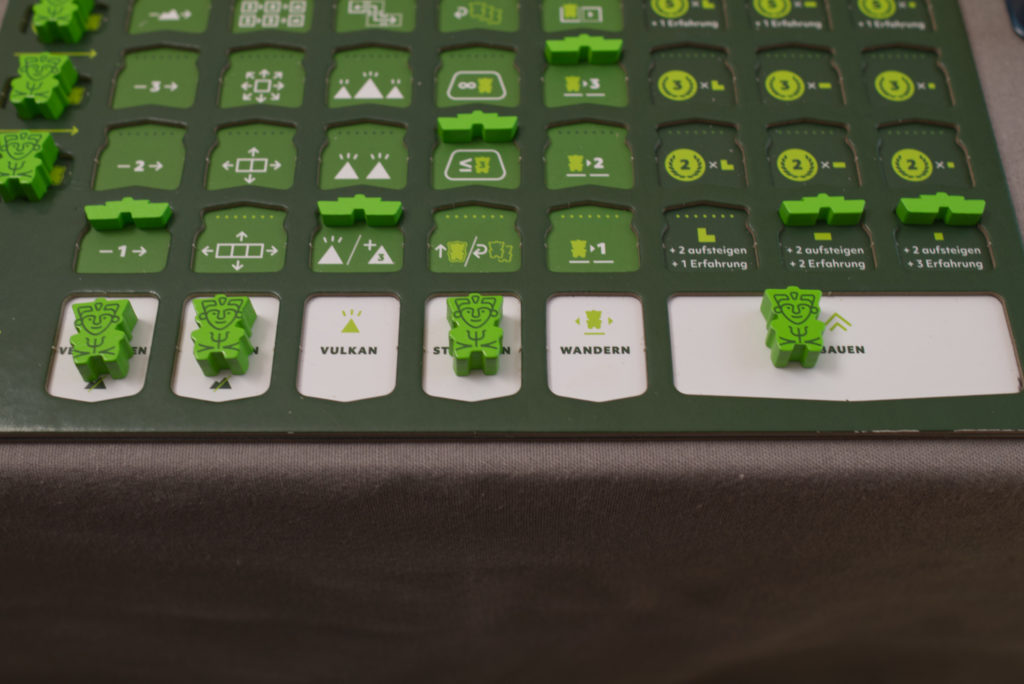
So what are the actions? Here is the lighting round explanation: Shift moves all pieces in a single row/column on the board in one direction, Move crashes a set of pieces into others to create bigger landmasses, Volcano lets players erupt volcano pieces on the board to create new land, Study makes pieces move between the player board and main board, Journey allows a player to move their meeples on the board, and finally Build allows them to construct sacred sites. The reason behind these becomes more apparent when talking about them in reverse order.
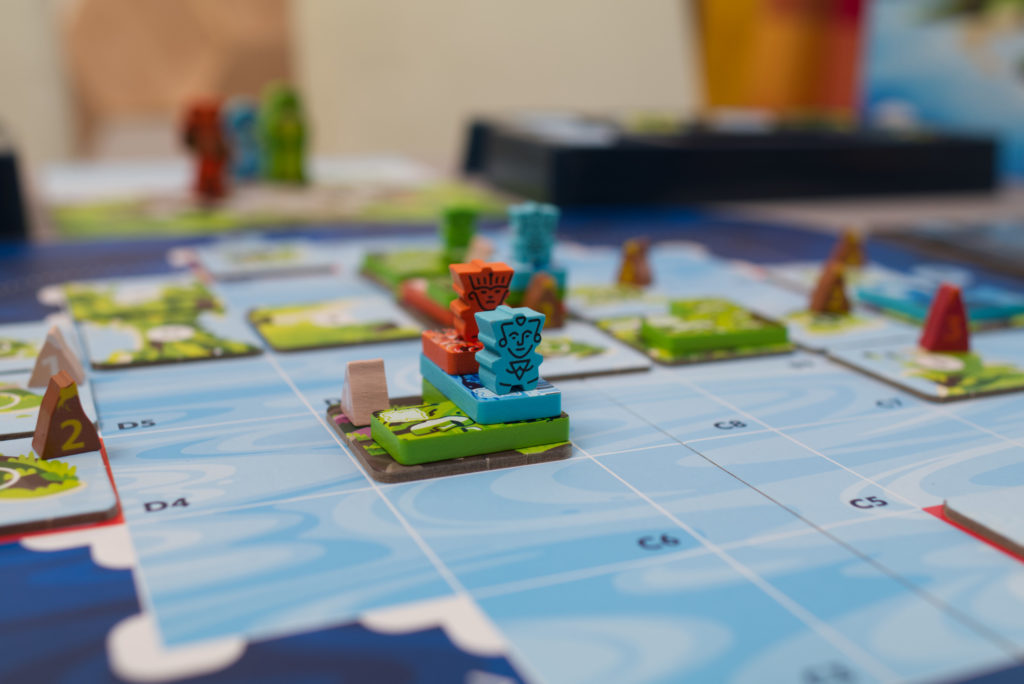
The players want to build sacred sites as these give them both upgrades of their powers as well as advances them on the Pyramid track. Sacred sites can only be built on mountain tiles or on top of other existing sacred sites by moving a meeple there and triggering the Build action. But how are mountains created? Simple, by moving two land tiles of size 4 into each other. Moving lower tiles into each other will combine them to a combined tile but not a mountain. Any access above 4 is instead converted into volcanic energy. So crashing a 3 and 2 into each other will create a single tile of value 4 and a value 1 volcano. Crashing an 4 and 3 into each other just turns the 3 into volcanic energy.
Volcanos are fun! When erupting, their lava first fills up the tile they are on and any access above 4 then can flow to an adjacent space, filling up that one. Besides creating the 4-land-tiles required for creating mountains, they have another nice side-effect: they create land connections. Meeples can only move from one tile to the next if both tiles share a land side with each other. So volcanos are always handy to bridge a gap and create a path to a lovely mountain an opponent spent a lot of work creating on.
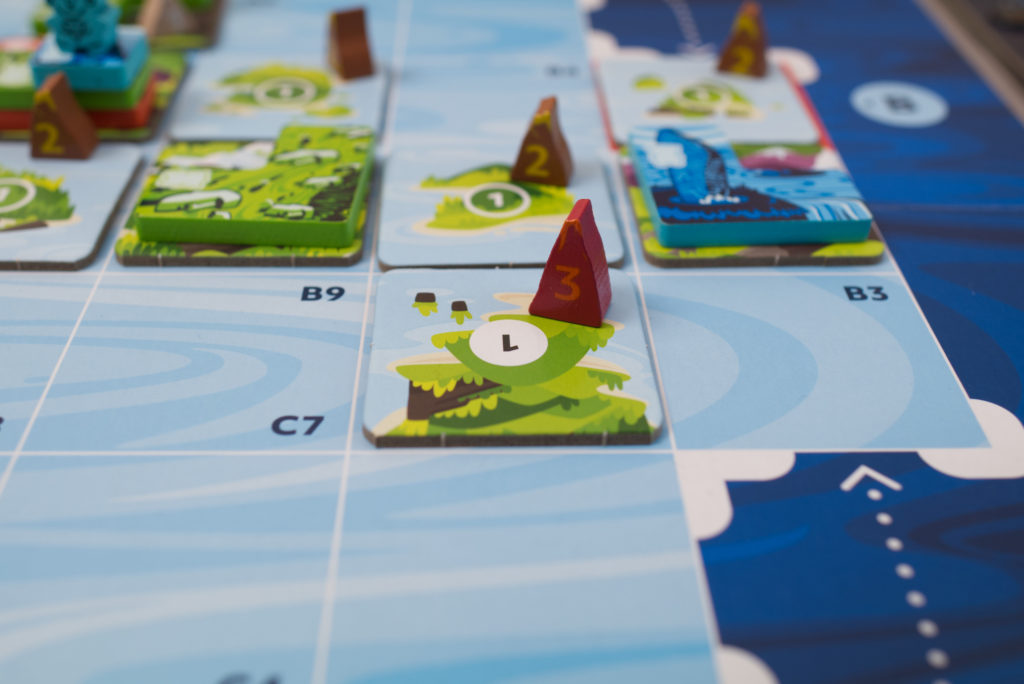
Speaking of movement, it’s initially very slow: your meeples can only move a single space per action and only over land-land connections. So it is quite common to place one of your meeples on a tile and instead shift the whole row or crash the tile into another tile, moving the meeple indirectly.
I’m omitting a couple of rules here to rather focus on the general feel, but basically that’s it. Crash land tiles into each other to create mountains and move your meeples over the board such that if a new mountain appears – no matter who created it – you’re there before your opponents have maxed out its building capacity.
The only piece that is missing is the Study action. When triggering this action, the player has a choice: either send a meeple to study (either on one of their already built sacred sites or one of the two study slots on their player board) or taking two meeples back from studying and placing them on empty action spots. Thus removing meeples has two effects: for each one, the player gets a free upgrade of a power. However, since the meeple has to placed on an action space, it also restricts what the player can do in subsequent actions. The more meeples are on action spaces and not studying or walking over the main board, the harder it becomes to execute the player’s turn.
End of Game
The game ends as soon as any player has reached the top of the pyramid and the current round is completed. VP are awarded for multiple things: first, each player earns VP based on the field of the pyramid they reached which has roughly been a quarter of the points in my games. Then each player gets either 3 or 7 points if they have reached the top two upgrade spots in a power. A big chunk of points come from the sacred sites one has created as the rightmost columns on the player boards are upgrades that increase the VP multiplier that player gets for a particular type of sacred suite. Finally, by unlocking rows of upgrades, a player can get additional VP for meeples studying on the board at the end of the game.
In general, Oros starts a bit slow because a lot of effort has to be spent to create the initial mountains and sacred sites. But the overall game arch is rather quick as things start to snowball rather quickly as players get more and more powerful in their actions. It very much is an efficiency race and the game is over when new players finally feel powerful enough to actually do stuff.
Solo Mode
A particularity of Oros is that it requires at least 3 parties to play. So for both solo and 2 player, automa have to be used. The back side of each player board represents an automa of different strength and behaviour. For each colour, a small set of cards is in the box that is used to figure out what actions the automa will perform on their turn. Each card shows a combination of creating sacred sites / studying, moving lands around, and advancing steps on the pyramid. The automa are designed for minimal admin work and are really fast to execute. The downside of this is twofold:
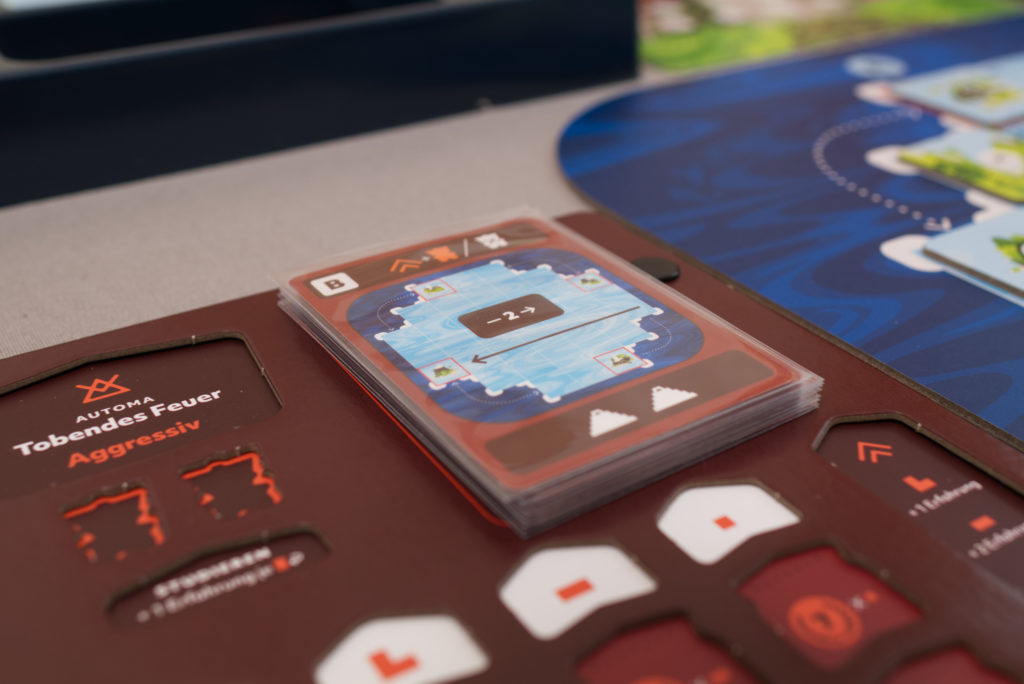
For one, the automa don’t move meeples over the board, which is an odd choice in a game that derives so much of its appeal from the spatial puzzle. Playing against the automa causes mountains to just suddenly appear out of open water or sacred sites being built in hard to reach places. Some automa even remove player pieces from the main board, something that normal players cannot do at all!
While playing solo, this produces an odd but compelling challenge. So far I’ve only won approx one out of three of my games. In my defence, I play against the stronger of the automa and the ratio would look a bit better against the more tamer ones. But even for those, one has to know the game to be competitive. The biggest disappointment here is that the automa cannot be used for the larger 4 player side of the board.
Where it becomes problematic is playing with 2 players. The automa acts as a largely unpredictable force of nature that follows no rime or reason. Especially since they start out way stronger than human players (can Shift 2 space and even move mountains, a capability that humans can only unlock way down the game), the effect of the automa can fluctuate between a nice element that messes up both players equally to something that throws back one player multiple rounds in their advancement while gifting the other easy to reach land masses. At least one player I played it with said they liked Oros a lot but would never ever play 2 player again.
So to be viable for two players, both either need to have a high tolerance towards randomness or be very experienced in Oros to somewhat be able to mitigate the blows. When you know what you are doing, a session is over in 45min so randomness doesn’t hurt as much as when you are a new player and the game takes rather 90min or longer.
Kickstarter Content and Modules
There are some additional pieces that can be used to modify the game besides varying the starting landscape. There is an extra “sacred mountain” tile and the starting player token has two sides, symbolising two variants that award/detract VP for some condition at the end game. So far I have neither felt the need or desire to use any of them.
The Kickstarter also comes with additional land tiles that have some hidden gimmicks. While neat in principle, having a pineapple or Dr. Who tardis poking out of the landscape really pulled me out of the experience. I’ve put them aside and they never leave the box for me. What I would have loved were more subtle things like having pieces with snow on them or otherwise different colours/art that still fits the mood of the game. Even subtle things like having a boat or stone circle sort of detracted from the game feel for me.
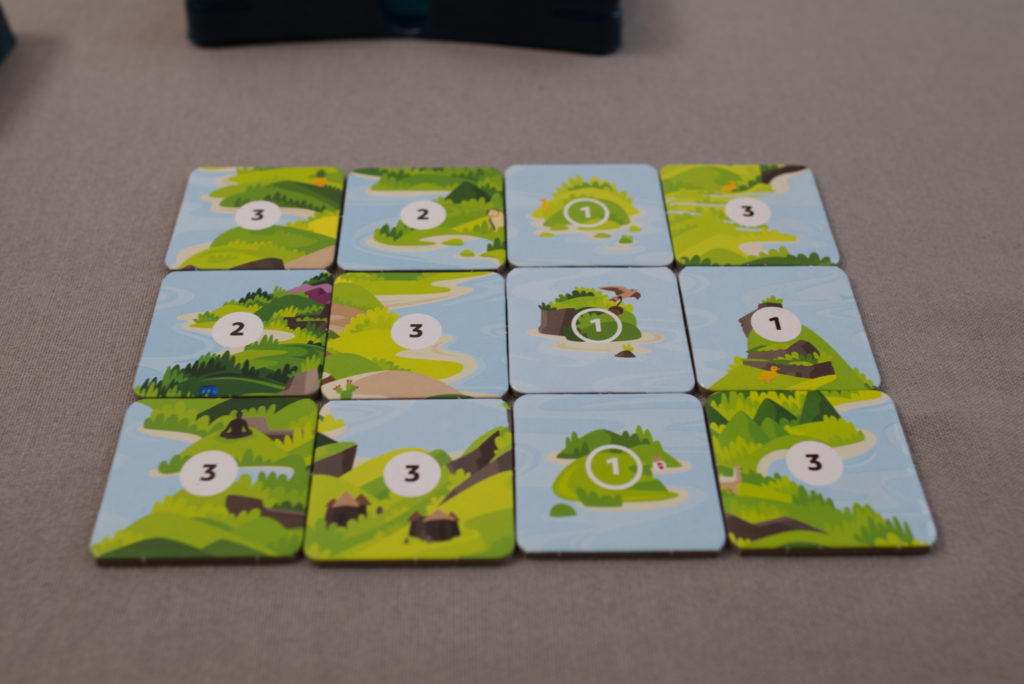
I also opted to get the optional playmat which I regret for two reasons: one, the tiles don’t slide in a straight line as well on the playmat as on the normal board. This in particular is important as one will be shifting whole rows a lot. Two, the print looks rather blurry. Or as a friend put it: the normal board just looks way nicer.
Conclusion
As you may have read between the lines, the Oros-experience so far has been kind of a mixed bag for me. On the one hand, it is really impressive what first time author Brandt Brinkerhoff has achieved here. The core game play is very solid, the production lovely, and Oros feels “fresh”. I couldn’t point you to another game I have played that feels quite like it, and with the number of games I play each year that really is an achievement. I wouldn’t have expected Oros to be this snappy and fast once you get the hang out of it. Just to put things into perspective, my solo games on average only take 10 rounds! So one has to be very deliberate which paths of upgrading powers one wants to approach. Another example of this is that each player only has 3 pieces of each level of sacred site. However, to reach that speed of play, it takes like 2-3 sessions for a player and to get those the sweet spot would have been the 2-player count which is arguably the weakest playing experience.
On the other end of the spectrum, I recently had a 4 player game with 3 players being completely new to the game. Oros almost grounded to a halt as one player was hooked by the challenge of finding a way to optimise their turn while the other two were still in the discovery phase of trying things and see what works. We had to prematurely aboard the game by cutting down the pyramid track as we had already been going for multiple hours. Oros can be a great puzzle with many different ways to achieve your goal, but as the example shows this can be its detriment with new players and large player counts. Another thing to look out for is that if two players synergise while others need to create their own mountains, those two will have a huge advantage.
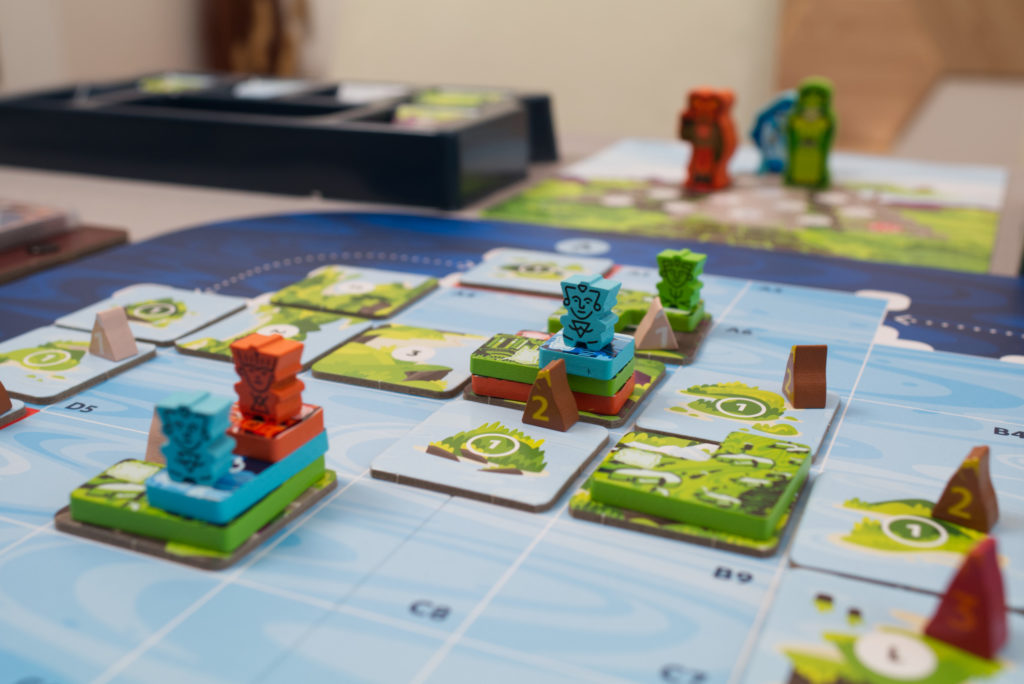
This puts me in an odd place: I’d really love to play Oros more, but after 10+ solo games the random nature of the bot keeps giving me the same single challenge. The two-player experience is dragged down by the automa, I rarely get four players that are a) not too casual for Oros to slow down and b) wouldn’t rather want to play a heavier game like Pax Pamir that shines with four players. So I need two other non-casual players that ideally would be on the same level of experience than me. This seems almost as impossible as getting four of my friends to agree to play Foundations of Rome with me so I can finally try it with five players. The author already hinted he is working on automa that allow playing on the larger map. I really hope someone will come up with a completely different automa approach that rather focuses on the spatial puzzle and predictably moves/blocks meeples instead of randomly building sacred sites in the middle of nowhere. Having a good automa that makes the two player experience the best would give Oros a giant boost.
Enough about player count, what about the different paths of upgrading powers? It might be the meta of my groups, but increasing the movement seems to be an almost necessary first step. When building sites, the meeple automatically jumps up on the site to study, but each level of site is a separate step to go down again. Since sacred sites are the only way to get meeples onto the board, it is essential to have a level 1 or 2 site in early game, and even a level 1 site already requires two steps to get down and to another tile. The most likely candidate for really pushing an upgrade seems to be the move (=crash) action as it is so powerful. Shifting is nice for big movements and pulling your opponents away from where they want to be, but in early game its usefulness is limited as more and more mountains reduce the number of rows that can be shifted – at least until one had a large number of upgrades and was able to push it so high that one is allowed to shift mountains Volcano is interesting and its usefulness seems to dependent on the initial starting configuration.
I really like the fact that multiple starting landscapes are in the rules and they actually feel different to play. What feels slightly odd is that the games two most stringent limitations (cannot shift mountains, cannot walk over water) both can be removed by upgrading the respective ability a lot. I’m not quite sure if this helps or hinders the game as I find the spatial restrictions of Oros the most interesting part of it. If for example, one never could walk over water, this would make volcanos that more important.
In general, it feels like there are 1-2 strategies that work well for anyone and another 1-2 approaches that might work well when players really know what they are doing or there is a particular initial setup. At first, I was a bit disappointed about that, but Oros is limited in what it can do while still aiming for that race-character. Based on my plays so far, I would say the really interesting challenge lies in the spatial situations and not in the tech tree. You’d be surprised how many different approaches of producing a mountain there are and trying to find the one that doesn’t give your opponent an edge is quite tricky.
One negative note besides the aforementioned playmat’s blurriness is that the coating of the main board looks nice, but I already have a giant scratch on the backside and I have no idea how that happened. I keep my gaming tables clean, but something must have gotten under there and really gone to town. A number of people have reported their player boards to warp and while this has happened to me as well, it isn’t as much as it would be an issue for me. However, it already seems to be scuffed up.
To wrap this up, Oros isn’t perfect but quite a fascinating game, an impressive effort for a first time designer and even more so for a one person designer-publisher! In some areas it feels over-designed (e.g. I think the cover would have looked even more amazing if there weren’t the white circles with the logos of the gods on it), I still haven’t found out what the giant hole in the bottom inlay is supposed to be for (hopefully future expansions), and the variants don’t feel that attractive to me. There are also some small usability problems like the fact that it is really easy to forget the initial limit of only being allowed to have one meeple on the board. But it is endearing as hell, from the artwork to the land shifting mechanisms to the tiny cute meeples. Once you see a meeple hopping off its sacred site onto a tile and then coasting along as it is shifted to another, better location on the board, you will struggle not to smile. Or another player shouts “heeeey” as you move their freshly created landmasses closer to where you are and the whole table erupts in laughter.
I can see a bright future for Oros, but it isn’t there quite yet. Give it a different automa that works well for two players and is more puzzle-like predictable, add some additional tiles that make the spatial puzzle tighter (e.g. tiles which one cannot walk through or whatever), and it will be an amazing hit. Some form of challenges or scenario/event deck that force players to follow different strategies (e.g. no one is allowed to upgrade movement over step 2 this game) would also be great. Up ’til then, I definitely recommend you check this game out. It’s fresh, it’s fun, just be aware of its quirks and you will have a good time!
